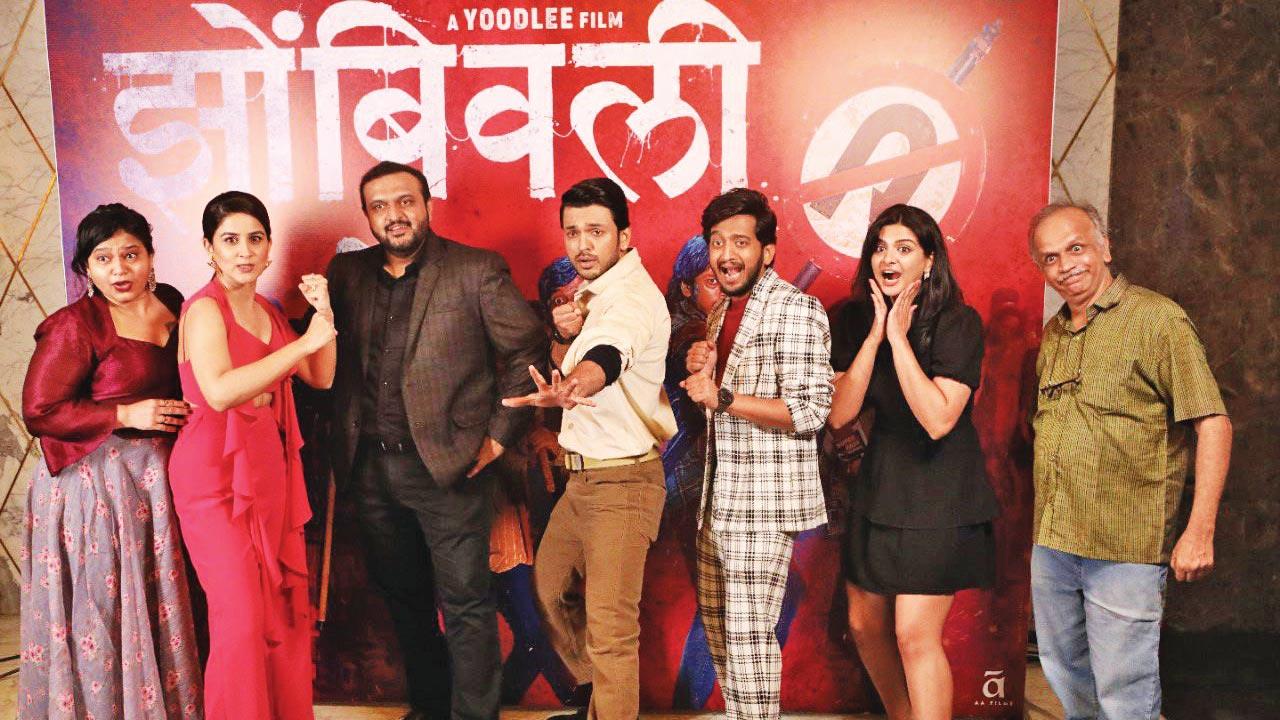Zombivli's team talks about creating zombie epidemic in middle-class Mumbai
8:12 AM
Posted by Fenil Seta

The team behind the first Marathi zombie film say their biggest challenge was placing a gory genre aced by Americans and Koreans in middle-class Mumbai
Nidhi Lodaya (MID-DAY; January 30, 2022)
A suburb in Thane district has become the seat of a fantastical phenomenon that was born as far back as 17th century in a Caribbean country. Marathi film director Aditya Sarpotdar is proudly taking credit for helming the first zombie film in Marathi, and that too, based on a story set in Dombivli. Zombivli, which released on January 26, stars Amey Wagh, Vaidehi Parashurami and Lalit Prabhakar, and is the story of Sudhir (Wagh), an engineer who, with his pregnant wife Sapna (Parashurami) moves into a housing colony that’s plagued by acute water shortage. The storyline leads up to a zombie attack which is sparked in a hospital due to infected water.
Historians say that the first references to the walking dead culture could date back to Ancient Greece where bodies were found held down by rocks. But it became popular in Haiti when West African slaves were brought to work in the sugarcane fields, and although death seemed dearer than the conditions they lived and worked in, the slaves resisted suicide for fear of turning into zombies, human in form, physically strong, but soulless and devoid of self-awareness. Their only aim, to feed on human flesh.
Sarpotdar, who has previously directed The Sholay Girl, Classmates, Satrangi Re and Mauli, says he was keen to keep the gore in check to make the tale a convincing one. He threw in humour, calling the horror comedy effort “zom com”. While Hindi films are seeing the genre slowly picking up in popularity with the success of Go Goa Gone, Stree and Roohi, Marathi cinema hasn’t had a serious brush with it. The mix of humour and thrill is one that he believes holds the promise of success. But it is a challenge “because, it is very difficult to scare the audience by building up the tempo to a moment of fear and then suddenly making them laugh.”
This, according to Sarpotdar is possible if you create a convincing world in which to place the characters. The humour crept in naturally because the universe in which the film is based is unfamiliar with zombies, and the manner in which the characters react to the walking dead, is unique and funny.
While one of the first references to a zombie film can be traced back to the 1930s, it’s the early 2000s when the genre once again took hold inspired by Japanese low budget films that were aping video games.
Sarpotdar was clear that he wouldn’t make the prosthetics and makeup over the top. “We wanted to make our zombies convincing for the Indian audience. They should not be grossed out; they should find them intriguing.”
Their reference for the execution were Korean zombie films, but more specifically, The Train to Busan (2016). However, the biggest challenge continued to be getting the makeup and look right. Yasmin Rodgers, the makeup artist who worked on the film, says, “Indian skin tones are dark unlike the Koreans who have fair skin. So, when we were creating the effects on the body, we realised that they were getting lost.”
She worked at making the “veins visible”. We did a lot of look and camera tests and tried different shades of green and red for the veins,” says Rodgers, who worked with a 15-member makeup crew. It would take about an hour to get a zombie ready and some scenes required as many as 80.
Sarpotdar says getting the makeup right makes the job of the special effects team a bit easier. For VFX artiste Ryan Mascarenhas, “my biggest challenge was to get the whitening of the eyes right.”
It was a first for many on the cast too, most of them have never worked in a fantastical film. Prabhakar had to learn to work with an out-of-control right hand his character had. “Getting the body language right was quite tough,” he says of the emotionless stance. “We also came up with some new words that sounded like cuss words but actually weren’t.”
That the film was born during the Coronavirus pandemic and shot between June and October 2020, meant that the team worked while having to honour lockdown restrictions. They chose not to shoot in Dombivli, they settled for Latur in Maharashtra. “A lot of the sequences have background replacements because we could not shoot in Dombivali since the Coronavirus cases were high in the area,” says Sarpotdar.

Director Aditya Sarpotdar (third from left) with the cast
This entry was posted on October 4, 2009 at 12:14 pm, and is filed under
Aditya Sarpotdar,
Bollywood News,
Coronavirus,
Latur,
Ryan Mascarenhas,
Yasmin Rodgers,
Zombivli
. Follow any responses to this post through RSS. You can leave a response, or trackback from your own site.
Subscribe to:
Post Comments (Atom)
Post a Comment